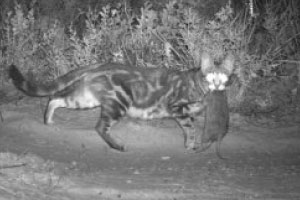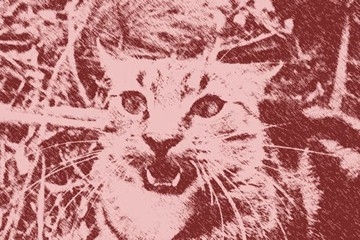
Feral cats: scourge or citizen?
When federal environment minister Greg Hunt made feral cats public enemy number one at the recent Threatened Species Summit his call to cull two million cats elicited an unexpected response from one quarter.

When federal environment minister Greg Hunt made feral cats public enemy number one at the recent Threatened Species Summit his call to cull two million cats elicited an unexpected response from one quarter.

Solving the problem of feral cats in the Australian environment will require long-term, well-resourced steps. But with the right will, it can be done.

Our new threatened species commissioner, Gregory Andrews, has already put a foot in the right direction by announcing that tackling feral cats will be high on his agenda.

The Action Plan for Australian Mammals 2012 has revealed that feral cats, followed by inappropriate fire regimes and the red fox are the greatest threats to Australia’s threatened mammals.

In 2008 there was a strong public outcry against the proposal by a cat breeder to import savannah cats – a hybrid of domestic cats and African servals (Felis catus X Leptailurus serval).

Prevention is best, but where invasive species have established, eradication, if feasible, is far better than long-term containment and control. This is the well-known hierarchy

In one of the great ecological ironies, the loss of predators can disadvantage their prey species. Top predators are ecosystem shapers, exerting control over smaller

Cat-lover or not, none of us can escape the devastating impacts feral and roaming cats are having on Australia’s wildlife.

Cat-lover or not, none of us can escape the devastating impacts feral and roaming cats are having on Australia’s wildlife.

Cat-lover or not, none of us can escape the devastating impacts feral and roaming cats are having on Australia’s wildlife.

This fact sheet on the impact of pet cats on Australian wildlife shows that pet cats allowed to roam and hunt are a major threat to local wildlife.

The introduction of cats to Australia has been a disaster not just for our wildlife, but has impacts on human health as well.

Domestic cats were introduced to Australia with the First Fleet in 1788. They are now one of the most damaging invasive species worldwide, and in Australia have been a major driver of mammal extinctions.

Our joint submission to the Australian Government’s inquiry into the problem of feral and domestic cats includes strengthening regulations for cat-free islands.

February 2017
Habitat loss is often assumed to be the main threatening process in Australia. This compilation of evidence demonstrates that invasive species are the main threat facing Australias declining mammals and frogs and, along with habitat loss and potentially climate change, represents one of the three main threats to biodiversity.

When federal environment minister Greg Hunt made feral cats public enemy number one at the recent Threatened Species Summit his call to cull two million cats elicited an unexpected response from one quarter.

Solving the problem of feral cats in the Australian environment will require long-term, well-resourced steps. But with the right will, it can be done.

Our new threatened species commissioner, Gregory Andrews, has already put a foot in the right direction by announcing that tackling feral cats will be high on his agenda.

The Action Plan for Australian Mammals 2012 has revealed that feral cats, followed by inappropriate fire regimes and the red fox are the greatest threats to Australia’s threatened mammals.

In 2008 there was a strong public outcry against the proposal by a cat breeder to import savannah cats – a hybrid of domestic cats and African servals (Felis catus X Leptailurus serval).

Prevention is best, but where invasive species have established, eradication, if feasible, is far better than long-term containment and control. This is the well-known hierarchy

In one of the great ecological ironies, the loss of predators can disadvantage their prey species. Top predators are ecosystem shapers, exerting control over smaller

Cat-lover or not, none of us can escape the devastating impacts feral and roaming cats are having on Australia’s wildlife.

Cat-lover or not, none of us can escape the devastating impacts feral and roaming cats are having on Australia’s wildlife.

Cat-lover or not, none of us can escape the devastating impacts feral and roaming cats are having on Australia’s wildlife.

This fact sheet on the impact of pet cats on Australian wildlife shows that pet cats allowed to roam and hunt are a major threat to local wildlife.

The introduction of cats to Australia has been a disaster not just for our wildlife, but has impacts on human health as well.

Domestic cats were introduced to Australia with the First Fleet in 1788. They are now one of the most damaging invasive species worldwide, and in Australia have been a major driver of mammal extinctions.

Our joint submission to the Australian Government’s inquiry into the problem of feral and domestic cats includes strengthening regulations for cat-free islands.

February 2017
Habitat loss is often assumed to be the main threatening process in Australia. This compilation of evidence demonstrates that invasive species are the main threat facing Australias declining mammals and frogs and, along with habitat loss and potentially climate change, represents one of the three main threats to biodiversity.

When federal environment minister Greg Hunt made feral cats public enemy number one at the recent Threatened Species Summit his call to cull two million cats elicited an unexpected response from one quarter.

Solving the problem of feral cats in the Australian environment will require long-term, well-resourced steps. But with the right will, it can be done.

Our new threatened species commissioner, Gregory Andrews, has already put a foot in the right direction by announcing that tackling feral cats will be high on his agenda.

The Action Plan for Australian Mammals 2012 has revealed that feral cats, followed by inappropriate fire regimes and the red fox are the greatest threats to Australia’s threatened mammals.

In 2008 there was a strong public outcry against the proposal by a cat breeder to import savannah cats – a hybrid of domestic cats and African servals (Felis catus X Leptailurus serval).

Prevention is best, but where invasive species have established, eradication, if feasible, is far better than long-term containment and control. This is the well-known hierarchy

In one of the great ecological ironies, the loss of predators can disadvantage their prey species. Top predators are ecosystem shapers, exerting control over smaller

Cat-lover or not, none of us can escape the devastating impacts feral and roaming cats are having on Australia’s wildlife.

Cat-lover or not, none of us can escape the devastating impacts feral and roaming cats are having on Australia’s wildlife.

Cat-lover or not, none of us can escape the devastating impacts feral and roaming cats are having on Australia’s wildlife.

This fact sheet on the impact of pet cats on Australian wildlife shows that pet cats allowed to roam and hunt are a major threat to local wildlife.

The introduction of cats to Australia has been a disaster not just for our wildlife, but has impacts on human health as well.

Domestic cats were introduced to Australia with the First Fleet in 1788. They are now one of the most damaging invasive species worldwide, and in Australia have been a major driver of mammal extinctions.

Our joint submission to the Australian Government’s inquiry into the problem of feral and domestic cats includes strengthening regulations for cat-free islands.

February 2017
Habitat loss is often assumed to be the main threatening process in Australia. This compilation of evidence demonstrates that invasive species are the main threat facing Australias declining mammals and frogs and, along with habitat loss and potentially climate change, represents one of the three main threats to biodiversity.
Get our blog the Feral Herald delivered to your inbox.

The Invasive Species Council was formed in 2002 to seek stronger laws, policies and programs to protect nature from harmful pests, weeds and diseases.
The Invasive Species Council acknowledges the Traditional Custodians throughout Australia and their connections to land and sea. We pay our respect to their Elders past and present and extend that respect to all Aboriginal and Torres Strait Islander peoples today.
Our protected areas are being trashed, trampled, choked and polluted by an onslaught of invaders. Invasive species are already the overwhelming driver of our animal extinction rate, and are expected to cause 75 of the next 100 extinctions.
But you can help to turn this around and create a wildlife revival in Australia.
From numbats to night parrots, a tax-deductible donation today can help defend our wildlife against the threat of invasive weeds, predators, and diseases.
As the only national advocacy environment group dedicated to stopping this mega threat, your gift will make a big difference.
A silent crisis is unfolding across Australia. Every year, billions of native animals are hunted and killed by cats and foxes. Fire ants continue to spread and threaten human health. And the deadly strain of bird flu looms on the horizon. Your donation today will be used to put the invasive species threat in the media, make invasive species a government priority, ensure governments take rapid action to protect nature and our remarkable native wildlife from invasives-led extinction, death and destruction.
If you are having trouble submitting a form, please read this guide.
Please fill out the following form and one of our team will be in contact to assist as soon as possible. Please make sure to include any helpful information, such as the device you were using (computer, tablet or mobile phone) and if known, your browser (Mozilla Firefox, Chrome, Safari etc)
"*" indicates required fields
Dear Project Team,
[YOUR PERSONALISED MESSAGE WILL APPEAR HERE.]
I support the amendment to the Kosciuszko National Park Wild Horse Heritage Management Plan to allow our incredible National Parks staff to use aerial shooting as one method to rapidly reduce feral horse numbers. I want to see feral horse numbers urgently reduced in order to save the national park and our native wildlife that live there.
The current approach is not solving the problem. Feral horse numbers have rapidly increased in Kosciuszko National Park to around 18,000, a 30% jump in just the past 2 years. With the population so high, thousands of feral horses need to be removed annually to reduce numbers and stop our National Park becoming a horse paddock. Aerial shooting, undertaken humanely and safely by professionals using standard protocols, is the only way this can happen.
The government’s own management plan for feral horses states that ‘if undertaken in accordance with best practice, aerial shooting can have the lowest negative animal welfare impacts of all lethal control methods’.
This humane and effective practice is already used across Australia to manage hundreds of thousands of feral animals like horses, deer, pigs, and goats.
Trapping and rehoming of feral horses has been used in Kosciuszko National Park for well over a decade but has consistently failed to reduce the population, has delayed meaningful action and is expensive. There are too many feral horses in the Alps and not enough demand for rehoming for it to be relied upon for the reduction of the population.
Fertility control as a management tool is only effective for a small, geographically isolated, and accessible population of feral horses where the management outcome sought is to maintain the population at its current size. It is not a viable option to reduce the large and growing feral horse population in the vast and rugged terrain of Kosciuszko National Park.
Feral horses are trashing and trampling our sensitive alpine ecosystems and streams, causing the decline and extinction of native animals. The federal government’s Threatened Species Scientific Committee has stated that feral horses ‘may be the crucial factor that causes final extinction’ for 12 alpine species.
I recognise the sad reality that urgent and humane measures are necessary to urgently remove the horses or they will destroy the Snowies and the native wildlife that call the mountains home. I support a healthy national park where native species like the Corroboree Frog and Mountain Pygmy Possum can thrive.
Dear Project Team,
[YOUR PERSONALISED MESSAGE WILL APPEAR HERE.]
I support the amendment to the Kosciuszko National Park Wild Horse Heritage Management Plan to allow our incredible National Parks staff to use aerial shooting as one method to rapidly reduce feral horse numbers. I want to see feral horse numbers urgently reduced in order to save the national park and our native wildlife that live there.
The current approach is not solving the problem. Feral horse numbers have rapidly increased in Kosciuszko National Park to around 18,000, a 30% jump in just the past 2 years. With the population so high, thousands of feral horses need to be removed annually to reduce numbers and stop our National Park becoming a horse paddock. Aerial shooting, undertaken humanely and safely by professionals using standard protocols, is the only way this can happen.
The government’s own management plan for feral horses states that ‘if undertaken in accordance with best practice, aerial shooting can have the lowest negative animal welfare impacts of all lethal control methods’.
This humane and effective practice is already used across Australia to manage hundreds of thousands of feral animals like horses, deer, pigs, and goats.
Trapping and rehoming of feral horses has been used in Kosciuszko National Park for well over a decade but has consistently failed to reduce the population, has delayed meaningful action and is expensive. There are too many feral horses in the Alps and not enough demand for rehoming for it to be relied upon for the reduction of the population.
Fertility control as a management tool is only effective for a small, geographically isolated, and accessible population of feral horses where the management outcome sought is to maintain the population at its current size. It is not a viable option to reduce the large and growing feral horse population in the vast and rugged terrain of Kosciuszko National Park.
Feral horses are trashing and trampling our sensitive alpine ecosystems and streams, causing the decline and extinction of native animals. The federal government’s Threatened Species Scientific Committee has stated that feral horses ‘may be the crucial factor that causes final extinction’ for 12 alpine species.
I recognise the sad reality that urgent and humane measures are necessary to urgently remove the horses or they will destroy the Snowies and the native wildlife that call the mountains home. I support a healthy national park where native species like the Corroboree Frog and Mountain Pygmy Possum can thrive.